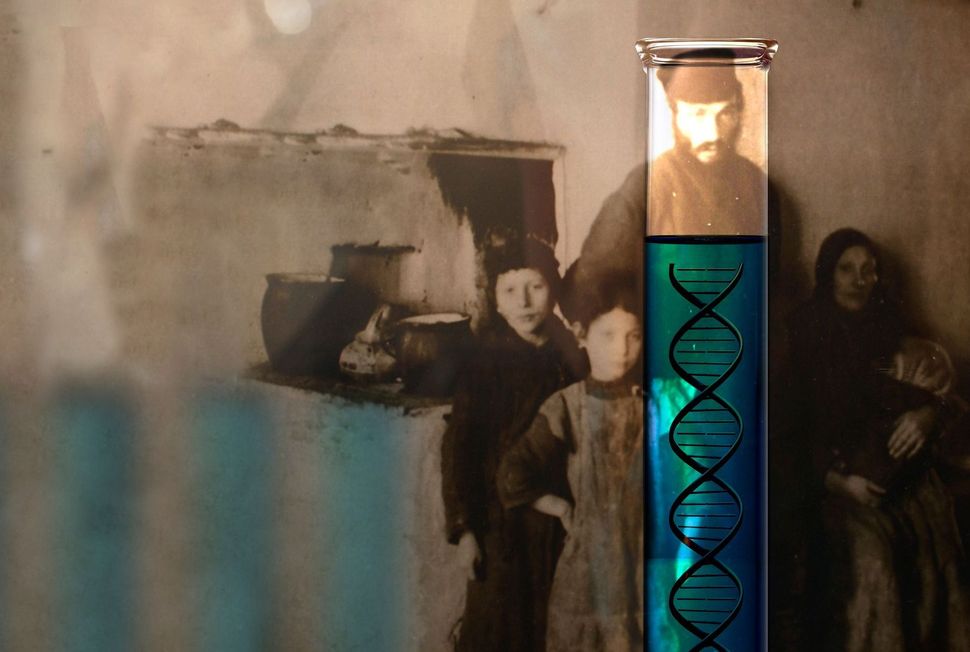23andMe’s Cool Update Does Bupkis For Most Ashkenazi Jews

Image by Nikki Casey
Many Ashkenazi Jews know only a few basic geographical facts about their ancestors: They came from Poland, but when it was Russia. Their great-grandparents hailed from Bulgaria — or was it Romania?
A number of Jews have turned to direct-to-consumer ancestry services like 23andMe and Ancestry.com for better answers, but they have gotten nowhere. This is because the vast majority of such tests don’t specify European Jewish ancestry by geography: “Ashkenazi Jewish” appears as a large, blue blob that extends from the top of Poland to Hungary and also includes Jews who hail from places like Lithuania and Ukraine.
This week, 23andMe announced a dramatic expansion of the number of geographical regions that can show up on a user’s ancestry report. Instead of “Broadly Northwestern European,” a person could be informed about having “Norwegian” genes. The list of 120 countries runs from Azerbaijan to Venezuela and will be incorporated into existing ancestry reports over the next few weeks.
But the update leaves Ashkenazi Jews in the lurch. 23andMe clients (such as this reporter) who have a significant chunk of the ancestry marked Ashkenazi Jewish won’t see that part of their ancestry specified in any way. That’s because Ashkenazi Jews are so closely related that even Jews from northwestern Poland and eastern Ukraine could appear to be fourth cousins, in terms of how much DNA they share. Which is to say that if you’re hoping to learn about whether you hail from Eastern Silesia or the village of Chelm, 23andMe simply can’t help.
“[I]f you’re not 100% Ashkenazi Jewish we may call other countries for you,” Andy Kill, a 23andMe spokesman, wrote in an email to the Forward. “However, if all or the vast majority of your heritage is Ashkenazi Jewish it’s likely you won’t get other countries or regions assigned to your results.”
“Jews in the 20th century and late 19th century have gone through this experience of genealogical rupture,” Steven Weitzman, a professor of Jewish history and the author of “The Origin of the Jews: The Quest for Roots in a Rootless Age,” told the Forward in 2017. “These genetic testing companies give you a very quick way to establish a connection to ancestors in the Old World.”
Without genealogical research, however, that connection will remain fairly geographically vague for most Ashkenazi Jews.
Overall, 23andMe’s update is a major improvement for its ancestry reports — the original list of population regions was 31. That created confusion for many users, some of whom would be shown unusually high or low genetic ancestry percentages from regions they knew to play a role in their family tree. People who tested their DNA through multiple services often found slightly different results, which often could be chalked up to the decisions each company made as to where it drew the boundaries around certain genetic populations.
For Jews with a significant proportion of non-Ashkenazi ancestry, the update may be a welcome clarification. According to 23andMe’s blog post about the update, the company will re-examine your DNA and match it with similar DNA samples. If you match with at least five other people whose DNA has been tied to one of the 120 new regions, you will be classified as belonging to that region. Every new regional match in your profile will be ranked by strength of the match, which in turn is based on the number of people you match with and how much of that region’s DNA you all share.
23andMe updates its genetic reports regularly with both new ancestral and health information. This news update was largely made possible by the dramatic increase in the number of people using the service. As of August of last year, the company had about 2 million customers — a number that likely spiked over the holiday season, when 23andMe’s testing kits were at the top of Amazon.com’s best-sellers list.
The updates include fun features like zooming in on geographic regions where your DNA is most likely to hail from. (23andMe determines your DNA’s history by matching it to samples taken from living residents of places around the world, or people who have genealogically verified ancestry and are seeing how similar their DNA is to yours.) The update even includes a mini-report on the amount of Neanderthal DNA in your genetic code.
While some Ashkenazi Jews have a significant amount of Neanderthal DNA, the updates will be out of reach for people with near-majority Jewish ancestry. Sephardic Jews generally can learn even less about their heritage than Ashkenazi Jews can. Because the DNA of different Sephardic communities — from Morocco, Greece, Iran and elsewhere — so closely resemble those home countries, there are few genetic sequences associated with Sephardic ancestry; there are fewer, at any rate, than those of Ashkenazi Jews, who were clustered in a land-locked part of Europe. 23andMe’s update, however, may help some Sephardic Jews specify which countries their ancestors hailed from — Tunisia instead of simply North Africa, for example.
23andMe has come under fire in recent months for not disclosing how it uses its customers’ DNA or disclosing how it secures data. Senator Chuck Schumer recently called on the Federal Trade Commission to look into 23andMe’s data selling practices. Consumer advocates have also warned people to be wary of what they can learn about their health from 23andMe’s health report, which includes information about risk of Alzheimer’s and Parkinson’s. Health reports have an additional cost beyond 23andMe’s basic ancestry report kit.
Contact Ari Feldman at [email protected] or on Twitter. @aefeldman

















